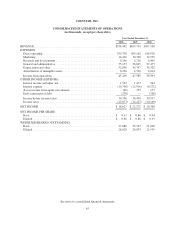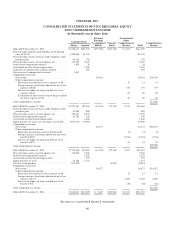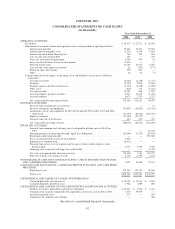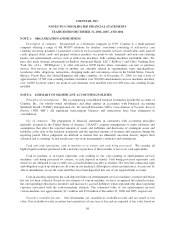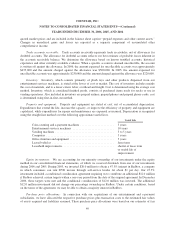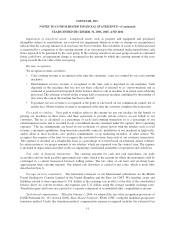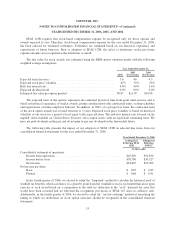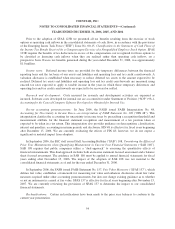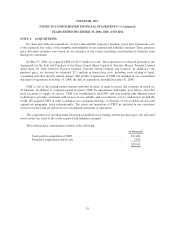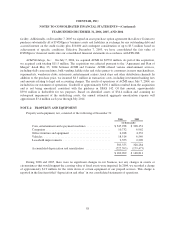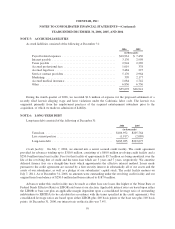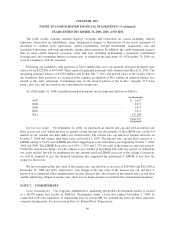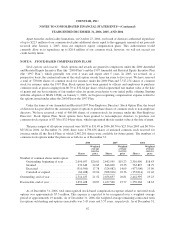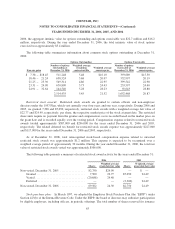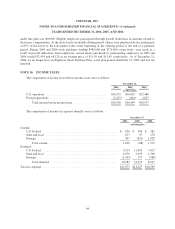Redbox 2006 Annual Report Download - page 56
Download and view the complete annual report
Please find page 56 of the 2006 Redbox annual report below. You can navigate through the pages in the report by either clicking on the pages listed below, or by using the keyword search tool below to find specific information within the annual report.COINSTAR, INC.
NOTES TO CONSOLIDATED FINANCIAL STATEMENTS—(Continued)
YEARS ENDED DECEMBER 31, 2006, 2005, AND 2004
Prior to the adoption of SFAS 123R we presented all tax benefits resulting from the exercise of stock
options as operating cash inflows in the consolidated statements of cash flows, in accordance with the provisions
of the Emerging Issues Task Force (“EITF”) Issue No. 00-15, Classification in the Statement of Cash Flows of
the Income Tax Benefit Received by a Company upon Exercise of a Nonqualified Employee Stock Option. SFAS
123R requires the benefits of tax deductions in excess of the compensation cost recognized for those options to
be classified as financing cash inflows when they are realized rather than operating cash inflows, on a
prospective basis. Excess tax benefits generated during the year ended December 31, 2006, was approximately
$1.0 million.
Income taxes: Deferred income taxes are provided for the temporary differences between the financial
reporting basis and the tax basis of our assets and liabilities and operating loss and tax credit carryforwards. A
valuation allowance is established when necessary to reduce deferred tax assets to the amount expected to be
realized. Deferred tax assets and liabilities and operating loss and tax credit carryforwards are measured using
enacted tax rates expected to apply to taxable income in the years in which those temporary differences and
operating loss and tax credit carryforwards are expected to be recovered or settled.
Research and development: Costs incurred for research and development activities are expensed as
incurred. Software costs developed for internal use are accounted for under Statement of Position (“SOP”) 98-1,
Accounting for the Costs of Computer Software Developed or Obtained for Internal Use.
Recent accounting pronouncements: In June 2006, the FASB issued FASB Interpretation No. 48,
Accounting for Uncertainty in Income Taxes—an interpretation of FASB Statement No. 109 (“FIN 48”). This
interpretation clarifies the accounting for uncertainty in income taxes by prescribing a recognition threshold and
measurement attribute for the financial statement recognition and measurement of a tax position taken or
expected to be taken in a tax return. This interpretation also provides guidance on derecognition, classification,
interest and penalties, accounting in interim periods, and disclosure. FIN 48 is effective for fiscal years beginning
after December 15, 2006. We are currently evaluating the effects of FIN 48; however, we do not expect a
significant or material impact from adoption.
In September 2006, the SEC staff issued Staff Accounting Bulletin (“SAB”) 108, Considering the Effects of
Prior Year Misstatements when Quantifying Misstatement in Current Year Financial Statements (“SAB 108”).
SAB 108 requires that public companies utilize a “dual-approach” to assessing the quantitative effects of
financial misstatements. This dual approach includes both an income statement focused assessment and a balance
sheet focused assessment. The guidance in SAB 108 must be applied to annual financial statements for fiscal
years ending after November 15, 2006. The impact of the adoption of SAB 108 was not material to the
consolidated financial statements as of and for the year ended December 31, 2006.
In September 2006, the FASB issued FASB Statement No. 157, Fair Value Measures (“SFAS 157”), which
defines fair value, establishes a framework for measuring fair value and enhances disclosures about fair value
measures required under other accounting pronouncements, but does not change existing guidance as to whether
or not an instrument is carried at fair value. SFAS 157 is effective for fiscal years beginning after November 15,
2007. We are currently reviewing the provisions of SFAS 157 to determine the impact to our consolidated
financial statements.
Reclassifications: Certain reclassifications have been made to the prior year balances to conform to the
current year presentation.
54



